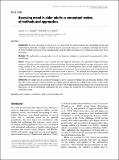Files in this item
Assessing mood in older adults : a conceptual review of methods and approaches
Item metadata
| dc.contributor.author | Brown, Laura | |
| dc.contributor.author | Astell, Arlene Jean | |
| dc.date.accessioned | 2013-07-29T14:01:01Z | |
| dc.date.available | 2013-07-29T14:01:01Z | |
| dc.date.issued | 2012-02-20 | |
| dc.identifier | 22331646 | |
| dc.identifier | cd4dcb9c-99fb-4829-b975-ab689921907f | |
| dc.identifier | 84862280163 | |
| dc.identifier.citation | Brown , L & Astell , A J 2012 , ' Assessing mood in older adults : a conceptual review of methods and approaches ' , International Psychogeriatrics , vol. 24 , no. 8 , pp. 1197-1206 . https://doi.org/10.1017/S1041610212000075 | en |
| dc.identifier.issn | 1041-6102 | |
| dc.identifier.uri | https://hdl.handle.net/10023/3888 | |
| dc.description | This work was supported by grant number RES354-25-0003, New Dynamics of Ageing (NDA) Programme. | en |
| dc.description.abstract | Background: Accurate measures of mood state are important for understanding and optimizing health and well-being in later life. A range of different mood assessment measures is available, reflecting the variety of ways in which mood has been conceptualized and the different purposes for which measures have been developed. Methods: We undertook a conceptual review of the literature relating to mood and its assessment in older populations. Results: Moods are subjective states of mind that are typically described and quantified using self-report measures. Moods can be conceptually differentiated from the related psychological concepts of emotion, well-being, quality of life, and depression. Quantitative tools for assessing mood state include single-item mood ratings, composite factor scales, and clinical depression assessments. Mood assessments may be administered retrospectively or contemporaneously to the mood state of interest. The method and temporal perspective used to assess mood state will impact on the nature and precision of the mood data that are collected, and the types of research questions that can be addressed. Conclusions: No single mood assessment technique can be considered optimal for all situations. Rather, both the type of tool and the temporal perspective taken must be selected according to the nature of the study design and the research question being addressed. More thorough and frank reporting of the rationale for, and limitations of, mood assessment techniques are also essential for continued development of mood research with older adults. | |
| dc.format.extent | 132113 | |
| dc.language.iso | eng | |
| dc.relation.ispartof | International Psychogeriatrics | en |
| dc.subject | Mood | en |
| dc.subject | Ageing | en |
| dc.subject | Affect | en |
| dc.subject | Happiness | en |
| dc.subject | Mental health | en |
| dc.subject | Quality of life | en |
| dc.subject | Depression | en |
| dc.subject | Q Science | en |
| dc.subject | SDG 3 - Good Health and Well-being | en |
| dc.subject.lcc | Q | en |
| dc.title | Assessing mood in older adults : a conceptual review of methods and approaches | en |
| dc.type | Journal article | en |
| dc.contributor.sponsor | Economic & Social Research Council | en |
| dc.contributor.institution | University of St Andrews. School of Psychology and Neuroscience | en |
| dc.contributor.institution | University of St Andrews. Institute of Behavioural and Neural Sciences | en |
| dc.identifier.doi | 10.1017/S1041610212000075 | |
| dc.description.status | Peer reviewed | en |
| dc.identifier.grantnumber | RES-354-25-0003 | en |
This item appears in the following Collection(s)
Items in the St Andrews Research Repository are protected by copyright, with all rights reserved, unless otherwise indicated.

